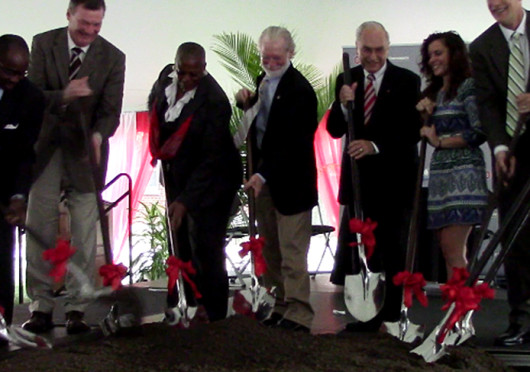
Senior OSU officials dig at the groundbreaking ceremony for the North Residential District Transformation Aug. 28 at Scott Lawn. The project is a $370 million renovation to North Campus. Credit: Andrea Henderson / Asst. multimedia editor
Leaders of Ohio State broke ground at Scott Lawn Wednesday in a ceremony to begin the North Residential District Transformation, which OSU Board of Trustees Chairman Robert Schottenstein called “the most ambitious and the most transformative housing initiative in the history of Ohio State.”
The North Residential District Transformation project is a $370 million renovation to North Campus that aims to enhance OSU’s Second-year Transformational Experience Program by adding 3,200 additional beds through the construction of 11 new buildings. The project is scheduled to be completed in the fall of 2016.
“Without a doubt, the STEP program and the North Residential District will transform the student experience at this university for better and different ways than ever before,” said interim OSU President Joseph Alutto at the groundbreaking ceremony.
The North Campus project is the “facility component” to OSU’s STEP, OSU Administration and Planning spokeswoman Lindsay Komlanc said in an email.
“The project will allow us to fully implement this experience (STEP) throughout our residential communities, while advancing the One Ohio State Framework Plan, which is the university’s long-range planning tool for our physical environment,” Komlanc said.
Jay Kasey, senior vice president for administration and planning, said the new residence halls will be essential for implementing the STEP program effectively because of the additional space they will provide.
“The buildings, on the ground floors, are all spaces that will be necessary to use the STEP program,” Kasey said. “There are small rooms for faculty to mentor students in, there are larger rooms for small groups to work in together and there’s larger spaces for big assemblies.”
The North Residential District Transformation project’s 3,200 new beds will replace 675 beds currently in buildings recommended for demolition, according to the North Residential District Plan on the OSU What’s Growing On website.
Buildings recommended for demolition include Scott, Nosker, Blackburn and Haverfield Houses as well as North, Royer and Raney Commons.
Kasey said he does not know when these buildings will be demolished at this point in the project phasing.
The project will also provide one- and two-story additions to Drackett, Jones and Taylor Towers, which will help better use basement spaces and improve Americans with Disabilities Act accessibility.
In addition to new residence buildings and renovations, the North Residential Transformation will bring two new dining facilities, a new fitness center, a retail pavilion at Lane Avenue and High Street and new outdoor recreational spaces to North Campus, according to an Office of Student Life and Facilities Operations and Development handout from the ceremony.
President of the Residence Halls Advisory Council and second-year in human development and family science Elizabeth Callow, who is also a STEP participant, said the construction of new accommodations for STEP students will be beneficial to both students’ personal growth and the growth of the university.
“The added spaces on campus for students to live is something that will provide them the ability to make additional opportunities in their second years,” Callow said. “Through having second-year students on campus they will be able to provide mentorship and leadership to their peers and underclassmen in environments that are really conducive to studying.”
First-year in art and Taylor Tower resident Jenny Chen said renovations to existing North Campus dorms and the construction of new ones will be proactive because of the wear and tear of the aging residence halls.
“These buildings are obviously really old,” Chen said. “In my bathroom the tile is coming out.”
Though the age of the buildings may have been a factor in the decision, some university officials said there were particular advocates of the project who got it to the point its at today.
Schottenstein said former OSU President E. Gordon Gee is the reason ground was eventually broken for the North Residential District Transformation.
“We wouldn’t be here today if it weren’t for Gordon,” Schottenstein said. “It was Gordon’s idea to do this. It was Gordon’s passion for the student experience and putting students first.”
Gee called the North Residential District Transformation “wholly transformative,” and a “unique educational experience” that will impact students, faculty, staff and surrounding OSU neighbors in a letter addressed to his colleagues in August 2012.
“The new plan will propel Ohio State into the front ranks of the modern American university, setting a new precedent for student engagement and community involvement. The two-year residential experience will promote personal growth and academic achievement from the moment students set foot on campus,” the letter read.
OSU announced in an April press release that it would save $26 million on the North Residential District Transformation after reviewing additional ways of delivering the project, bringing the budget to $370 million.
Messer Construction will lead the project team that will finalize the design and start the construction on the project.


